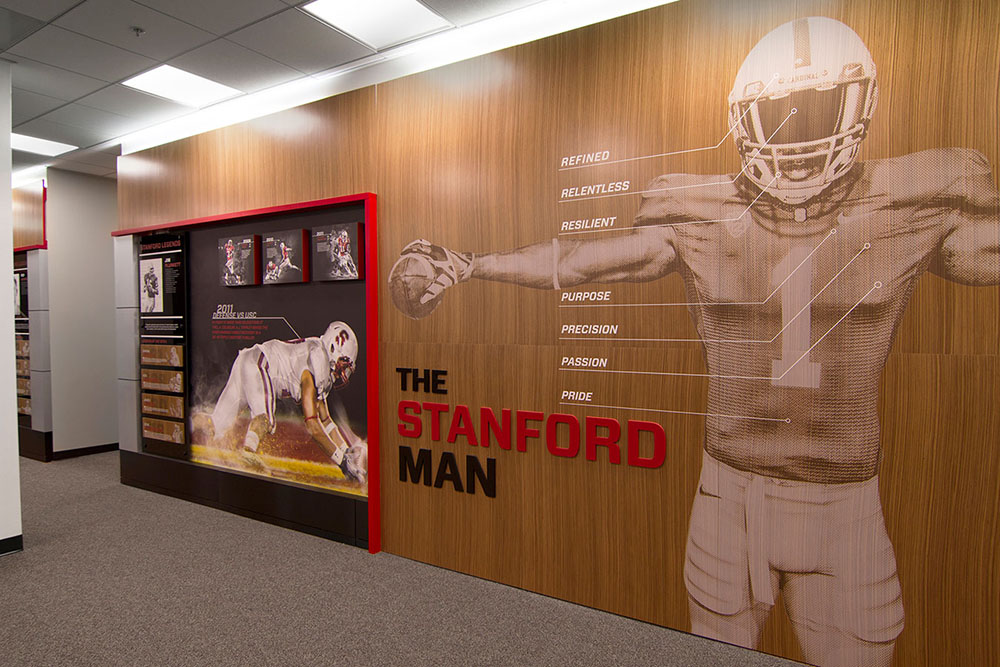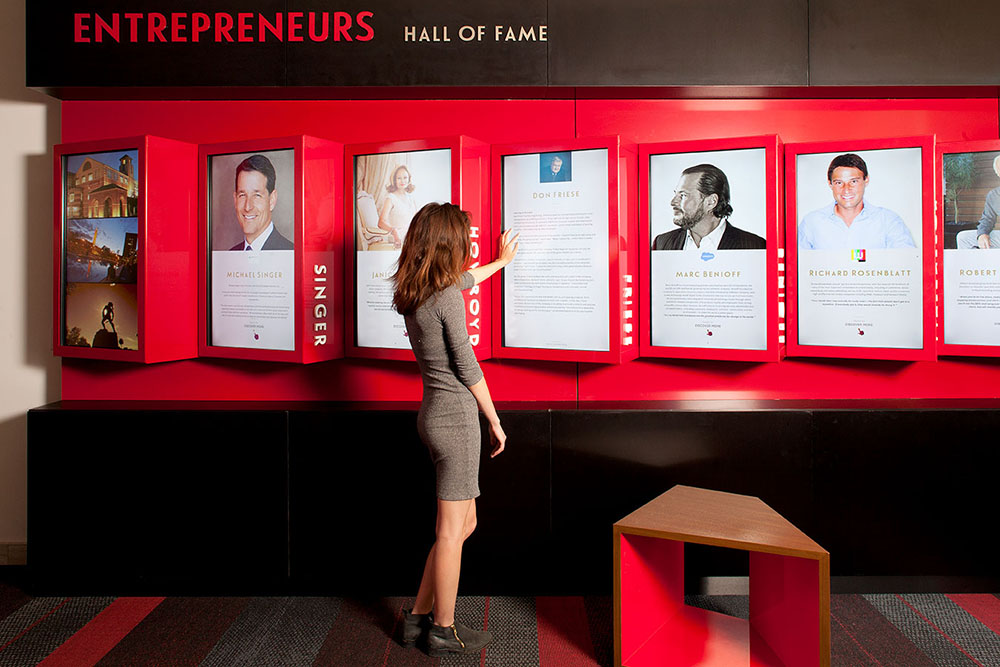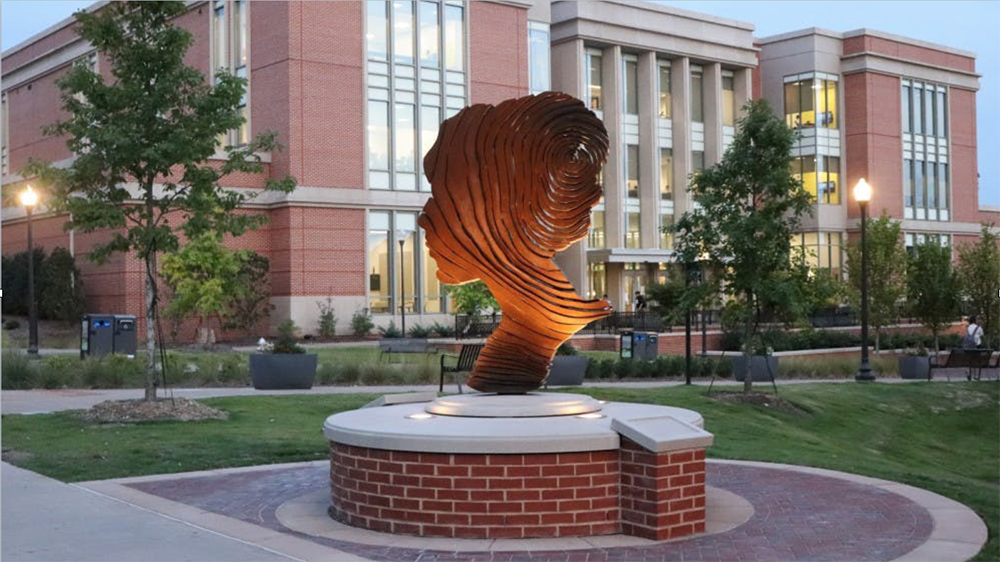Dispelling the Facilities Arms Race Myth

Iwas asked to present at this year’s Campus Facilities Summit in Nashville. While there, I heard presentations about budget constraints and the reality of enrollment being down. There are plenty of reactions to these challenges, including the temptation to jump head-first into the “facilities arms race.” I juxtaposed this train of thought. I want to dispel the myth that there’s a facilities arms race. I want to try to get universities focused on the thought of telling stories within your building and throughout your campus.
The NPR host, Ira Glass, says, “Great stories happen to those who can tell them.”
What about the idea of using your space as a canvas for stories? There’s a lot of hype around the arms race. And you may have used the phrase yourself. Don’t get me wrong, I think facilities are crucial. But during a time where centennials and prospective students are weighing the value of a college education, here’s what you need to kind of step into… If you build a new building, and the campus next to you builds a new building, we’re at parity. And all we’re going to do is end up in this endless battle of investment over who has the newest building.
 I have four sons. We’re about to be empty nesters. The last one is a senior. Hank is receiving college letters in the mail from every college I can name. Now if you look through those, they’re going to talk about “go from here to anywhere.” They’re going to talk about “discover yourself.” They’re going to talk about themes that really converge and really look ubiquitous. It’s a sea of sameness. And if we’re not careful, if we focus on facilities, especially if we focus on building new state-of-the-art facilities, and we let all of our consultants tell us what state-of-the-art we put in, our state-of-the-art building is going to look just like the Jones’ state-of-the-art building down the road. That doesn’t focus on the point of differentiation. Why would you choose my state-of-the-art building over the Jones’?
I have four sons. We’re about to be empty nesters. The last one is a senior. Hank is receiving college letters in the mail from every college I can name. Now if you look through those, they’re going to talk about “go from here to anywhere.” They’re going to talk about “discover yourself.” They’re going to talk about themes that really converge and really look ubiquitous. It’s a sea of sameness. And if we’re not careful, if we focus on facilities, especially if we focus on building new state-of-the-art facilities, and we let all of our consultants tell us what state-of-the-art we put in, our state-of-the-art building is going to look just like the Jones’ state-of-the-art building down the road. That doesn’t focus on the point of differentiation. Why would you choose my state-of-the-art building over the Jones’?
Are your competitors your benchmark? Because what I would like to offer is to take that yoke off and think instead about how you can empower your stakeholders to more effectively express what makes their programs unique.
When you host campus tours, everyone knows we’re going to the student union, the engineering building, the dorm. If it’s on a Saturday, the classrooms are empty. And we’re looking through this chicken wire window to see what’s going on in there.
What’s really going on in there may be that they discovered some way to provide folks who had been injured with robotic limbs. Or maybe they discovered a way to use automation to cure medical issues or concerns. But it’s hard to see that when you’re looking at the empty classroom.
If we think about some of the buildings that you may be focused on, what’s the story of that building? Who came out of that building that may have had an impact on their industry, or may have had an impact on culture? All of the data is telling us that generation Z, the centennials, they want to go to school now in order to have a solid career. How are you showcasing the stories of those who’ve come before in the building in a way that connects with the audience? Because stories define the culture.
So let me give you a really pragmatic example of this. Out in Los Angeles, at the USC Marshall School of Business, we installed this entrepreneurs’ hall of fame. It’s a series of touch screens and highlights the key entrepreneurs. You can touch to find out more about each of those entrepreneurs. I’m an entrepreneur. I’ll tell you, in most cases, we’re really strong C students when we’re in school. But they go on to do some interesting things that kids, young folks, prospective students, can relate to.
 It could be digital. It could be static. But what you’re trying to say is there’s a face, maybe it’s of a minority, maybe it’s a more youthful entrepreneur, there’s a face that I identify with. I want to find out more. And then in doing so, they drill further into the story and find inspiration. That’s one way to do it. There’s another way to do it.
It could be digital. It could be static. But what you’re trying to say is there’s a face, maybe it’s of a minority, maybe it’s a more youthful entrepreneur, there’s a face that I identify with. I want to find out more. And then in doing so, they drill further into the story and find inspiration. That’s one way to do it. There’s another way to do it.
We designed a statue at Auburn that celebrates 125 years of women’s enrollment at the university. It’s in the middle of campus. Every student passes by it. Auburn decided this is a story that needs to be told, especially in today’s culture. As you walk around this statue, you really can take it in. But that’s a story. That university not only celebrates women and their enrollment in the university, they’ve been doing it for 125 years. That’s something that past, present and future students can relate to.
 So I ask you, if these walls could talk, what would they say? What would they say that further differentiates you from the clutter of ubiquity, from the folks down the street who just installed a new building?
So I ask you, if these walls could talk, what would they say? What would they say that further differentiates you from the clutter of ubiquity, from the folks down the street who just installed a new building?
Think about two attention attributes when you approach a building. One is utility. What’s the usefulness? What’s the adjacency? How do we need to put this department with this department? Where do the bathrooms need to be? How big do they need to be? That’s something that the architects and the builders are going to naturally discuss.
The other is experience. If a family has made the investment to come for a campus tour, how can we not rely on the admissions team to tell the story verbally? How can we get the student to ask questions and want to learn more?
I had a gentleman at the conference ask a question that I really valued. The question was, “How do you deal with a university that really focuses on research and being preeminent in terms of its research, and the prospective student may not care so much about the story?”
My response was to flip that narrative.
The prospective student doesn’t care about the research in the terms that the chancellor or the dean wants to put it. Numbers being published mean little if they don’t result in a story. The prospective student cares about if that research is changing the world. They want to be part of something that is larger than themselves.
That is a story that you need to tell. So just like I was speaking earlier about robotic limbs—that’s a story that needs to be told. It is leading edge research, but it’s research that’s making a difference.
I’m going to leave you with five tips.
1. Focus on the experience and not just the function. It’s an architect’s job to keep water out of the building. But it’s also someone’s job to keep people in the building, keep them engaged. That will be based on the experience.
2. Determine the stories that make the difference. How is your university different than the other universities? Maybe it’s in the community. Maybe it’s in the alumni. Maybe it’s in the professor. Maybe it’s in the discoveries. Tell those stories. Tell them to an audience who is crazy visual and crazy immersive more than we’ve ever seen before.
3. Program those stories into the building. Create those elevated moments.
4. Consider the customer journey. Restaurants, retail, hospitality, they all think about this. What is the customer journey like? There’s a reason milk and eggs are in the back of the grocery store. Because most people need that and they walk by everything else on the way there.
5. Lastly, don’t be sucked into the arms race. I would just like to give you that gift. I just don’t think you should be a part of it. Let’s not give it life by acknowledging that it exists because if we do that, we’re just going to build fancy state-of-the-art buildings that are just going to be superseded by the next fancy state-of-the-art building down the road.
Below is the full version of my speech at CFS, with some insightful questions from the audience following.